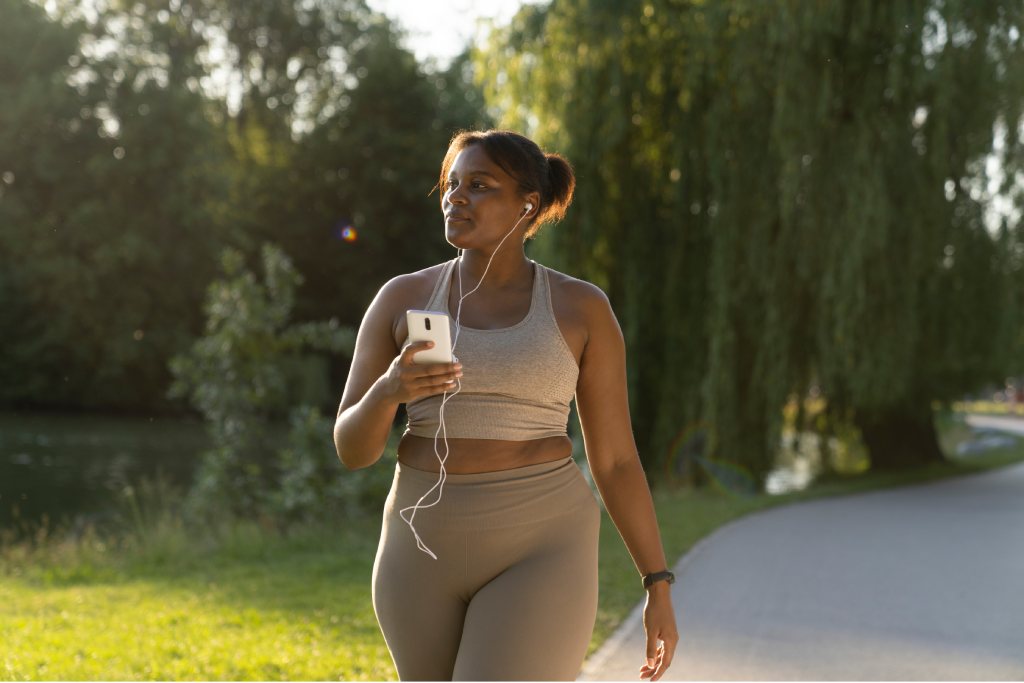Humans and their ancestors have been running for millions of years. But it’s only in our modern times that we have come to fully appreciate the benefits of running.
Exercising regularly doesn’t only feel good – it can make you healthier and stronger and help you shed those stubborn extra pounds.
Running is one of the most accessible forms of exercise. It requires little equipment, and you can easily adapt it to your fitness level and goals.
From strengthening muscles and joints to supporting eye health, running has a host of documented health benefits. Let’s take a closer look at the reasons why you should be running.
In This Article
In This Article:
17 Proven Benefits of Running
So, what is running good for? Can running help you with weight loss and muscle building? Does it do anything at all for your upper body? And just how many calories can running burn? Read on to find out what sports medicine has to say about running.
1. Running builds muscle and stronger joints

As your feet pound the ground, your muscles and joints withstand beneficial stress. All your muscles, from your glutes in your hips to your calves, become stronger under the strain. Running builds muscle over time, with proper rest and nutrition.
Running also strengthens your joints, possibly warding off osteoarthritis. A 2017 study found that recreational runners had lower rates of arthritis in the hips and knees than non-runners or competitive runners.
Another study found that marathon runners had a significantly lower hip or knee arthritis rate than the general US population. That said, it’s important to remember that long-distance running is a high-impact physical activity. Rest your body in between runs to reduce the risk of injury.
2. Running improves mental health
A meta-analysis of 23 randomized controlled trials found that exercise has a notable effect on improving depression symptoms. While exercise alone cannot replace doctor-prescribed antidepressants, the findings suggest exercise can complement them.
Running is one of the most convenient and enjoyable forms of aerobic exercise you can follow regularly. Running reduces stress hormone levels, inducing a state of relaxation that can decrease anxiety and improve sleep.
To tap into the brain health advantages of running, you don’t need to run every day. However, you need to run several times a week at a moderate or higher intensity. Your running time should contribute to a total of at least 300 minutes of physical exercise a week.
3. Running burns calories
Running at a moderate or higher pace burns more calories than dancing, jogging, swimming, weight training, or playing basketball. You can burn over 100 calories running a 10-minute mile.
Just how many calories you burn running depends on your weight, pace, terrain, and other factors. For example, a 120-pound person running at a moderate pace will burn, on average, 11.4 calories per minute.
If you run to lose weight, remember that a healthy and balanced diet plays a key role in shedding extra pounds. Not reducing your caloric intake can make losing weight difficult even if you exercise regularly.
4. Running improves cardiovascular health
Running just 5–10 minutes a day at a slow pace (<6mph) significantly reduces the risk of cardiovascular disease. It also reduces the risk of mortality from heart disease. Running more increases the benefits for your cardiovascular system.
Put simply, running regularly is one of the best things you can do for your cardiovascular heart. That’s because running exercises the most important muscle of your body – the heart. At the same time, it works your lungs and increases blood flow to your muscles.
5. Running increases bone density
Running is a high-impact exercise, but that can be good for your bones. Research suggests that long-term runners have higher bone density than cyclists and people who engage in resistance training.
Dense bones are less likely to break. Bone density also contributes to overall body composition and bone health, which is especially important in older age. With that in mind, running too much too soon can stress your bones and joints and lead to injury.
Wearing running shoes with good cushioning is important. Maintaining a healthy body weight also helps reduce the stress of running on your bones.
6. Running can lower the risk of diabetes
Diabetes is a chronic disease that leads to a buildup of blood sugar. Over time, high blood glucose can have adverse health effects such as heart disease or vision loss.
The good news is that following a running program can lower the risk of type 2 diabetes, the most prevailing form of the condition. A 2019 study on leisure time running found that runners had a 28% lower risk of developing type 2 diabetes than non-runners.
Other forms of physical activity may add up to lowering this risk. You can include strength training and cross-training in between your running workouts.
7. Running connects you with nature

Whether you run in a park or try trail running, running can bring you closer to nature in a way that going to the gym can’t. The sound of birds chirping, the sun touching your skin, and the wind blowing through your hair can elevate running to a richer experience than a mere workout.
A 2022 study that compared outdoor running with treadmill running found that both improved fitness and decreased fat percentages.
However, the researchers found that outdoor running led to greater physical fitness. What’s more, another recent study concluded that running in nature is more enjoyable than running in an urban setting.
8. Running fosters community
Taking part in a running event or simply jogging with a friend can add a valuable social element to your regular physical activity. In the age of screens, running regularly can encourage face-to-face interaction with other runners.
More than sharing running experiences and comparing running shoes, hitting the trail or track alongside others can lead to valuable new friendships.
Running with others can also help you maintain a consistent training regimen and achieve your running goals. Online and offline, running clubs are easy to find today in most states.
9. Running improves your immune system
Running benefits your immune system, too, provided you don’t push yourself too hard. A review article on exercise immunology research suggests that acute exercise can boost your immune system. This means running at a moderate to vigorous pace for less than 60 minutes.
By contrast, high-intensity runs and long competitive runs generate mental and physical stress that may affect your immune system. This doesn’t mean you should skip these. Only that it’s important to balance shorter, moderate-intensity runs with more challenging ones.
It’s also important to eat right, stay hydrated, and give your body enough time to rest in between runs.
10. Running can lower the risk of cancer
Observational studies show that consistent running can reduce the risk of cancers of the bladder, breast, colon, esophagus, kidney, stomach, and uterus.
What’s more, aerobic exercise, including running, can benefit cancer survivors. It can reduce depressive symptoms and improve quality of life. It may even reduce the risk of mortality in breast, colorectal, and prostate cancers.
It’s important to note that running with a chronic medical condition may call for a carefully personalized running workout.
11. Running helps you get better sleep

Do you find it difficult to fall asleep? Or do you wake up feeling tired? Running regularly can have physical and mental health benefits that lead to better sleep.
Running can lower your core body temperature and boost serotonin levels, which may help realign your internal body clock. It’s not just running that impacts sleep. Quality sleep impacts running, too – good sleep can boost your energy and help you run better.
To boot, running for at least 75 minutes a week can reduce the risk of death from lack of sleep. But don’t run before bedtime. Your body will stay in high gear for a while and may prevent you from falling asleep.
12. Running reduces blood pressure
Running regularly makes your heart stronger. This enables the heart to pump more blood with less effort and ease pressure on your arteries. The result is lower blood pressure.
High blood pressure is a major contributing factor to heart problems. It can go on unnoticed for years. Although it’s more prevalent in the elderly, it may occur in younger adults as well.
More than 100 million Americans have high blood pressure, according to the American Heart Association. Establishing a running routine can be an effective way to manage blood pressure regardless of age.
13. Running can improve your memory
We’ve already seen that running benefits mental health. The mental benefits of being a runner include better brain function as well.
A randomized controlled trial found that aerobic training significantly increased the volume of the hippocampus in elderly women with mild cognitive impairment. Located in the temporal lobe of the brain, the hippocampus plays a key role in learning and memory.
Other research indicates that consistent moderate exercise can increase gray matter in multiple brain regions. To run in the aerobic zone, you need to achieve a heart rate between 70–80% of your maximum heart rate. That means engaging in moderate to vigorous intensity exercise.
14. Running increases energy levels
It may sound counterintuitive, but running can give you an energy boost after you step out of your running shoes. Add to that good sleep and a healthy diet, and your energy levels can significantly increase during the day.
Like other forms of exercise that bring about exertion, running makes your body produce more mitochondria in muscle cells. These generate fuel for your body from glucose.
At the same time, running increases oxygen, blood flow, and the release of endorphins. Together, these changes enable your body to produce more fuel and better use energy stores. Jogging benefits energy levels, too, so you can run at a slower pace.
15. Running improves skin health
We’ve seen that running can help keep your heart healthy and ward off chronic diseases. But findings from a research study suggest it can also help you counteract the effects of aging on your skin.
Elderly lifelong runners had a lower advanced glycation end products accumulation (AGEs) in their skin and tendons than untrained runners. AGEs are associated not only with aging but also with lifestyle diseases.
However, it’s important to remember that UV exposure can damage the skin. Wear sunscreen when running in the sun and avoid overexposing your skin to sunlight.
16. Running supports eye health
Preventing eye diseases is easier than having to treat them. The good news is that the health benefits of running extend to eye health too.
Mounting evidence suggests that regular exercise, such as running, can protect eye health. Running may reduce the risk of macular degeneration and glaucoma, leading causes of vision loss in the United States.
Furthermore, running has also been associated with an improvement in dry eye symptoms.
17. Running boosts confidence and self-esteem

The wide-ranging positive effects that running can have on your body can make you feel and look better. With this comes more confidence and self-esteem.
Following a training program, tracking your progress, and participating in competitions can help build self-confidence and a love for running. After all, completing a half-marathon or marathon is no mean feat.
Running also helps you increase mental stamina and resilience, qualities you can take into other areas of your life. In the end, more than a workout, running is a great way to tap into many health benefits.
How to Start Running
Before your feet start pounding the pavement, it helps to define your running goals. Do you want to run for better overall health? Or do you have performance targets that you want to reach?
Based on your answer and your available time, you can determine how much you will train and where.
Investing in at least a pair of running shoes and other appropriate gear is also important. At the very least, you want wicking running wear that doesn’t hold sweat and a running bottle for hydration. You can also grab a pair of headphones since running with music can make your workouts more fun.
Following a personalized running workout is the easiest and safest way to achieve healthy running goals like weight loss or better cardiovascular fitness. Also, make sure to let your body rest and eat enough calories to power your body through your runs.
Tip: We dedicated a post to the 4 simple steps to start running. Check it before heading out for your first run!
FAQs
Does running build muscle?
Running regularly builds muscle in the lower body, strengthening your glutes, quadriceps, hamstrings, and calves. Sprinters and other fast runners tend to build considerably more muscle than endurance runners.
This occurs because fast runners use mostly fast twitch muscle fibers, which show more pronounced growth. Eating a protein-rich diet and resting are crucial to building muscle, and runners are no exception.
What does running do for your body?
Running has far-reaching effects on your body. It improves cardiovascular health, burns body fat, helps with weight maintenance, and strengthens lower-body muscles, joints, and bones.
Running also improves mental health, boosts your energy, and can improve sleep quality. On the other hand, running also puts stress on your bones and joints. It can increase the risk of injury if you don’t allow yourself enough breaks in between runs.
Is it healthy to run every day?
Running every day increases your risk of injury and may not give your muscles enough time to recover and grow. It may cancel out some of the health benefits of running.
As with other forms of exercise, it’s usually best to factor in enough rest days in your training plan. That said, running every day can be safe only if you do it for short periods of up to 10 minutes.
How long does it take to see results from running?
While you may experience the runner’s high and better sleep after your first run, performance improvements usually show after at least 4 weeks.
Energy and mood improvements often follow shortly after you start running. For long-term health benefits such as fat loss, muscle building, and stronger joints, you have to wait several months.
Takeaways
There are more than a dozen reasons why running is good for you beyond the simple pleasure of running. And the liberating feeling that comes with moving more every day.
Running has heart health benefits. It can prevent common chronic diseases, reduce your risk of mortality, make your bones and joints stronger, and even slow down skin aging. It also supports cognitive function, improves sleep, and can increase your energy.
An effective way to burn calories, running can help you lose body weight while spending more time outdoors. In the end, it’s one of the most effective forms of exercise and one that almost anyone anywhere can pick up.
When you run regularly, you transform your body and mind. Running as a habit can help you become a stronger, faster, and more balanced version of yourself.
Starting your running journey becomes easier with the right companion at your side. Joggo provides a personalized running plan according to your goals.
And since eating right is crucial to losing weight and running at your best, Joggo generates a personalized meal plan with over 10 most popular diets. You also get educational articles with smart tips and tricks.
References:
- Koplan, J.P., Powell, K.E., Sikes, R.K., Shirley, R.W. and Campbell, C.C., 1982. An epidemiologic study of the benefits and risks of running. Jama, 248(23), pp.3118-3121.
- Major, W.F., 2001. The benefits and costs of serious running. World Leisure Journal, 43(2), pp.12-25.
- Szabo, A. and Ábrahám, J., 2013. The psychological benefits of recreational running: A field study. Psychology, health & medicine, 18(3), pp.251-261.
- Wolf, I.D. and Wohlfart, T., 2014. Walking, hiking and running in parks: A multidisciplinary assessment of health and well-being benefits. Landscape and Urban Planning, 130, pp.89-103.
- Lee, D.C., Brellenthin, A.G., Thompson, P.D., Sui, X., Lee, I.M. and Lavie, C.J., 2017. Running as a key lifestyle medicine for longevity. Progress in cardiovascular diseases, 60(1), pp.45-55.
- Yeh, H.P., Stone, J.A., Churchill, S.M., Brymer, E. and Davids, K., 2017. Physical and emotional benefits of different exercise environments designed for treadmill running. International journal of environmental research and public health, 14(7), p.752.
- Harris, M.B., 1981. Runners’ perceptions of the benefits of running. Perceptual and Motor Skills, 52(1), pp.153-154.














